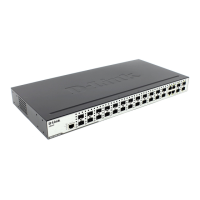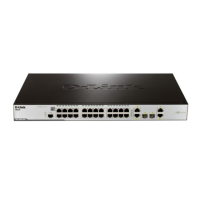xStack
®
DGS-3400 Series Layer 2 Gigabit Ethernet Managed Switch
6
Aging Time
without being accessed (that is, how long a learned MAC Address is allowed to remain idle). To
change this, type in a different value representing the MAC address age-out time in seconds.
The MAC Address Aging Time can be set to any value between 10 and 1,000,000 seconds. The
default setting is 300 seconds.
IGMP Snooping
To enable system-wide IGMP Snooping capability, select Enabled. IGMP snooping is Disabled
by default. Enabling IGMP snooping allows the user to specify use of a multicast router only
(see below). To configure IGMP Snooping for individual VLANs, use the IGMP Snooping
window under the IGMP Snooping folder.
IGMP Multicast
Router Only
This field specifies that the Switch should only forward all multicast traffic to a multicast-enabled
router, if enabled. Otherwise, the Switch will forward all multicast traffic to any IP router. The
default is Disabled.
MLD Snooping
To enable system-wide MLD Snooping capability, select Enabled. MLD snooping is Disabled by
default. Enabling MLD snooping allows you to specify use of a multicast router only (see below).
To configure MLD Snooping for individual VLANs, use the MLD Snooping window under the
MLD Snooping folder.
MLD Multicast
Router Only
This field specifies that the Switch should only forward all multicast traffic to a multicast-enabled
router, if enabled. Otherwise, the Switch will forward all multicast traffic to any IP router. The
default is Disabled.
GVRP Status
Use this pull-down menu to enable or disable GVRP on the Switch.
Telnet Status
Telnet configuration is Enabled by default. If you do not want to allow configuration of the
system through Telnet choose Disabled.
Telnet TCP Port
Number (1-65535)
The TCP port number used for Telnet management of the Switch. The "well-known" TCP port for
the Telnet protocol is 23.
Web Status
Web-based management is Enabled by default. If you choose to disable this by selecting
Disabled, you will lose the ability to configure the system through the Web interface as soon as
these settings are applied.
Web TCP Port
Number (1-65535)
The TCP port number used for Web-based management of the Switch. The "well-known" TCP
port for the Telnet protocol is 80.
RMON Status
Remote monitoring (RMON) of the Switch is Enabled or Disabled here.
Link Aggregation
Algorithm
The algorithm that the Switch uses to balance the load across the ports that make up the port
trunk group is defined by this definition. Choose MAC Source, MAC Destination, MAC Src &
Dest, IP Source, IP Destination or IP Src & Dest (See the Link Aggregation section of this
manual).
Switch 802.1X
MAC Address may enable by port or the Switch’s 802.1X function; the default is Disabled. This
field must be enabled to view and configure certain windows for 802.1X. More information
regarding 802.1X, its functions and implementation can be found later in this section, under the
Port Access Entity folder.
Port-Based 802.1X specifies that ports configured for 802.1X are initialized based on the port
number only and are subject to any authorization parameters configured.
MAC-based Authorization specifies that ports configured for 802.1X are initialized based on the
port number and the MAC address of the computer being authorized and are then subject to any
authorization parameters configured.
Auth Protocol
The user may use the pull-down menu to choose between RADIUS EAP and Local for the
802.1X authentication protocol on the Switch. The default setting is RADIUS EAP.
802.1X Authen
Network RADIUS
The user may use the pull-down menu to Enable or Disable the 802.1X Authen Network
RADIUS on the Switch. The default setting is Enabled.
802.1X Authen
FailOver
The user may use the pull-down menu to Enable or Disable the 802.1X Authen FailOver on the
Switch. The default setting is Disabled.
Forward EAPOL
PDU
The user may use the pull-down menu to Enable or Disable the Forward EAPOL PDU on the
Switch. The default setting is Disabled.
HOL Prevention
If this option is Enabled it prevents the forwarding of data to a port that is blocked. Traffic that
would normally be sent to the buffer memory of the Switch’s TX queue is dropped so that
memory usage is conserved and performance across all ports remains high.

